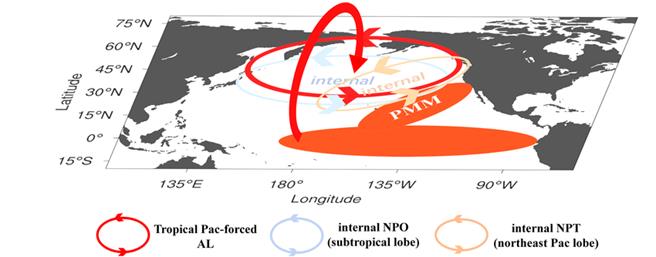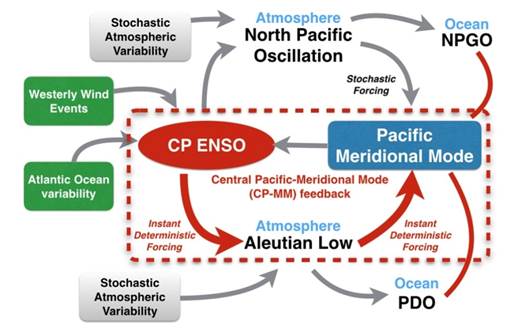Description

Disclaimer: Copyright infringement not intended.
Context
- Deadly summer heat-waves in north-central India can be linked to a climate pattern in the Pacific called the Pacific Meridional Mode (PMM), according to a new study.
Read all about Heat Waves here: https://www.iasgyan.in/rstv/heat-waves-and-climate-change
Pacific Meridional Mode (PMM)
- Pacific Meridional Mode (PMM) is a climate mode in the North Pacific. In its positive state, it is characterized by the coupling of weaker trade winds in the northeast Pacific Ocean between Hawaii and Baja California with decreased evaporation over the ocean, thus increasing sea surface temperatures (SST). The scenario is reverse during its negative state.
- This coupling develops during the winter months and spreads southwestward towards the equator and the central and western Pacific during spring, until it reaches the Intertropical Convergence Zone (ITCZ), which tends to shift north in response to a positive PMM.
- The North Pacific Oscillation (NPO) and the "North American Dipole"—two climate oscillations over the North Pacific and North America—trigger PMM modes during winter.
- Temperature fluctuations in the North Atlantic and the West Pacific oceans and changes in Arctic sea ice have also been proposed as triggers for PMM events.
- The PMM state can modulate hurricane activity in the East Pacific and typhoon activity in the West Pacific oceans and alter precipitation on the continents surrounding the Pacific Ocean.

- The PMM appears to be mainly a consequence of stochastic (random) climate forcing in the extra-tropics albeit with influence from the atmospheric background state.
- The North Pacific Oscillation (NPO)—the atmospheric counterpart of the North Pacific Gyre Mode— can trigger PMM events mainly via SST anomalies off the coast of Baja California.

PMM and ENSO
- The PMM is not the same thing as the El Niño-Southern Oscillation (ENSO), but there is evidence that PPM events can trigger ENSO events, especially Central Pacific El Niño events.
- The South Pacific Ocean has a PMM-like mode known as the "South Pacific Meridional Mode" (SPMM) that also influences the ENSO cycle.
- In the early 21st century, the intensity of the 2014–16 El Niño event and the highly active 2018 Pacific hurricane and typhoon seasons have been attributed to positive PMM events. With anthropogenic global warming, PMM activity is likely to increase, and some scientists have proposed that a loss of Antarctic and especially Arctic sea ice will induce future positive PMM events.
Heat waves, PMM and India: Background
- In recent decades, heat waves have caused more deaths than any other natural hazard. The recent deadly heat-waves of 2015 and 2019, claimed more than 1,200 lives.
- Though the impacts of Indian summer heat-waves on human health have become well-known in recent years, there is little understanding of what factors drive the heat-wave events in the country.
- So, Experts from India, Europe and the United States collected daily maximum temperature and rainfall data from the India Meteorological Department from 1951–2019 to investigate the factors responsible for heat-waves.
- They also performed climate model experiments to understand the links between the heat-wave and PMM, focusing on the last 500 years.
- The team suspected El Niño / Southern Oscillation (ENSO), a climate pattern emerging from the interaction between the atmosphere and ocean in the tropical Pacific, could be responsible. But nearly 66 per cent of the total heat-wave events had occurred during non-ENSO years.
- Thus, analysis showed that the PMM was exerting significant control on the May-June heatwaves over north-central India.
Impact of PMM on India
- There have been far-reaching impact of PMM and its novel association to extreme temperatures over the northern Indian region,
- The PMM, weakens a zonal Walker circulation over the Pacific. A Walker circulation is like a loop, with airflow in the lower part blowing from east to west across much of the tropics and the flow in the upper part from west to east at higher altitudes. A weakened Walker circulation, in turn, changes lower-level westerlies (winds blowing from the west in mid-latitudes) into easterlies (dry, cold prevailing winds blowing from the east over the Indian ocean). This, according to the study, creates conditions ripe for hot and dry summers over north and central India.It could impact the monsoon.
- A positive PMM phase is characterized by the weakening of westerlies over the Indian region during June, and these processes delay the monsoon onset. When sufficient moisture is not entering the Indian landmass, there is a decline in rainy days over India, specifically during June. This exacerbates the heatwaves.
Read:
ENSO: https://www.iasgyan.in/blogs/all-about-enso-and-mjo
https://www.iasgyan.in/daily-current-affairs/heat-waves-and-enso
https://www.downtoearth.org.in/news/climate-change/what-is-behind-deadly-summer-heatwaves-in-north-central-india--84940

















